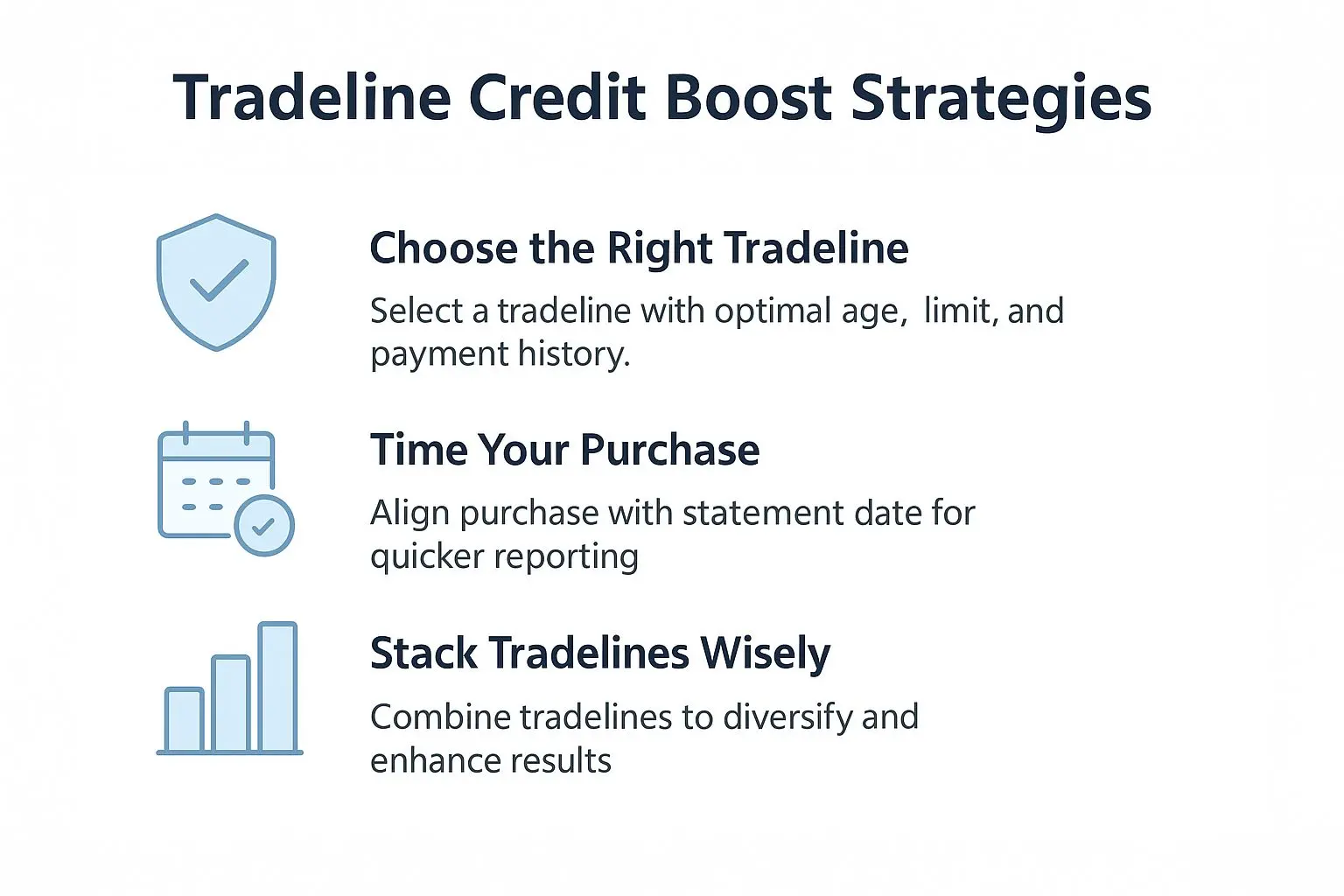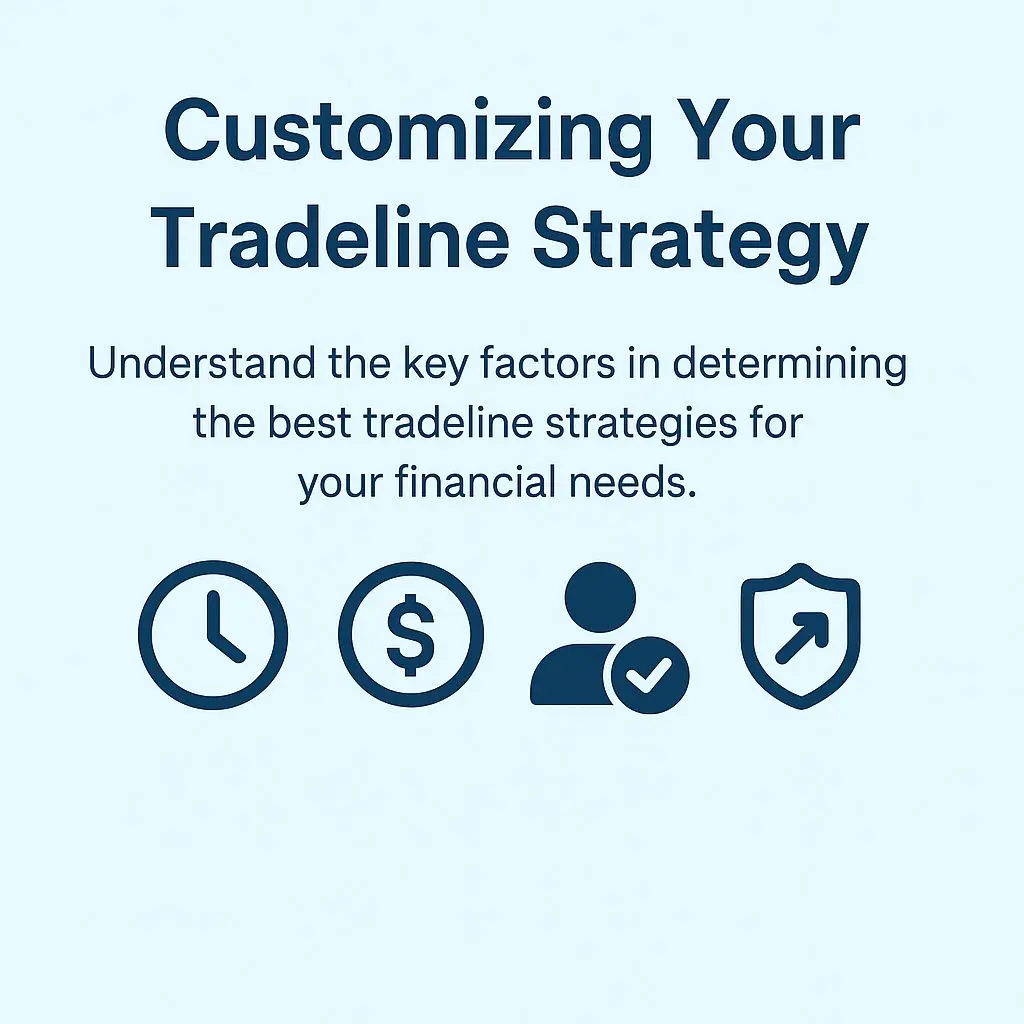Tradeline Credit Boost Strategies
Learn how to choose the right tradeline package and timing for maximum credit report impact.
Explore Tradeline Score’s homepage to learn how it all works. Need help selecting a tradeline?
Visit our Buy Tradelines page for real-time inventory and package options.

Watch: 3 Smart Strategies to Boost Credit Using AU Tradelines
If you’re aiming to improve your credit profile, this video walks you through three powerful AU tradeline strategies that work. From choosing the right age and limit to aligning your posting window with credit reporting cycles, these tips help maximize results. Tradeline Score breaks down how tradeline credit boost strategies should prioritize tradeline selection, timing, and quality to get the best lift—safely and legally. Start planning smarter, and get results that count.
When it comes to choosing the right tradeline credit boost strategies, timing and structure matter more than most people realize. We’ve seen that buyers who select tradelines based on their reporting cycle and statement date tend to experience smoother results than those who choose based on price alone. In most cases, matching your tradeline purchase with your credit report’s update window is a key part of maximizing impact.
Our experience shows that selecting a tradeline with at least two years of age and a low utilization ratio—ideally under 10%—can offer a stronger lift to your profile, especially when paired with other well-maintained accounts. These kinds of strategies to boost credit using tradelines have consistently shown better outcomes for users who understand how to align multiple data points. That said, every credit file is different. What works for one person might not work exactly the same for another, which is why we generally recommend reviewing your credit report before purchasing.
At Tradeline Score, we’ve built our platform to give you flexibility in applying different tradeline credit boost strategies depending on your goals. Whether you’re trying to reduce utilization, improve account diversity, or strengthen the average age of credit, we provide filtering tools to help you make informed, compliant decisions backed by real-time inventory and transparent pricing.
According to the Consumer Financial Protection Bureau, nearly 1 in 10 consumers begin building credit through authorized user accounts. This highlights the potential impact of AU tradelines when used as part of a responsible credit-building strategy.
Using Tradelines Strategically for Credit Profile Growth
Tradelines can influence various parts of your credit profile, such as account age, utilization ratio, and number of revolving accounts. While no tradeline vendor can guarantee a specific score increase, understanding how tradelines interact with credit scoring models can help you make better purchase decisions.
Whether you’re preparing for a mortgage, rental application, or new credit card approval, selecting the right tradeline can support your financial goals—especially when paired with good timing and profile alignment. Learn more about eligibility criteria to increase your success rate.
Tradelines serve as a tactical tool for improving creditworthiness. Knowing how and when to leverage them—along with choosing the appropriate tradeline type—can offer meaningful outcomes for users aiming to strengthen their credit report without shortcuts. Buyers who implement smart tradeline credit boost strategies often see the best results by aligning purchases with their broader financial goals.
At Tradeline Score, we’ve seen that the most effective tradeline credit boost strategies aren’t about chasing quick fixes—they’re about using credit-building tools with intention and timing. For example, adding a tradeline right before a lender pulls your report may help your profile appear more established, especially if the tradeline has a low utilization ratio and a strong payment history.
In most cases, credit profiles benefit the most when tradelines are selected based on specific goals and reporting timelines. Someone trying to qualify for a mortgage might prioritize age and payment history, while another buyer may need to target utilization improvement. These buyer-specific credit tradeline boost strategies are why we emphasize evaluating both your credit report and the tradeline’s attributes before making a decision.
Our platform is designed to help users apply tradeline credit boost strategies that actually fit their financial timelines. From filtering by statement dates to reviewing account history before purchase, every part of the experience is built for transparency. We believe that a well-informed buyer makes better decisions—and ultimately gets better results.
For a cost-effective start, see our curated list of cheap tradelines for sale.
📈 Top Tradeline Credit Boost Strategies
Choose Seasoned Tradelines (≥2 Years Old)
The older the tradeline, the stronger the impact on the age of your credit history — a key FICO factor.
Pick Low-Utilization Cards
AU tradelines with under 10% utilization can improve your credit score by reducing overall credit usage.
Stack Strategically — Don’t Overdo It
Buying 2–3 high-quality tradelines is usually more effective than stacking 5+. Focus on quality, not quantity.
Time It Right Before Major Applications
Apply tradelines 15–30 days before a mortgage, auto loan, or credit card application for maximum score visibility.
Always Use Escrow-Protected Platforms
Using a secure escrow platform ensures you’re protected in case the tradeline doesn’t post as expected.
Tradeline Credit Boost Strategies – Key Factors That Influence Tradeline Effectiveness
- Account Age: Older tradelines may increase average credit age, a factor in FICO models.
- Credit Limit: Higher limits may help lower overall utilization rates if matched to the right profile.
- Payment History: All tradelines on our platform have a perfect payment record—this helps establish trust on your report.
- Bureau Reporting: Match tradelines that report to the bureaus your lenders will review.
To maximize results, compare seasoned vs. new tradelines and determine which account age is optimal for your goals. For utilization-focused strategies, explore our high vs. low limit guide.
Additionally, stacking multiple tradelines—when done correctly—can diversify your profile and reduce risk factors associated with thin credit files. The key is to avoid overdoing it, and instead, build with intent.
In our experience, users who get the most out of tradeline credit boost strategies are those who take the time to align each purchase with their specific credit goals. For example, someone preparing for a mortgage may benefit more from older tradelines with high limits and a clean history, while another person trying to lower utilization quickly might prioritize newer tradelines that post fast and offer flexibility. By applying personalized tradeline credit boost strategies, users can focus their efforts where they’ll make the most impact.
We typically see the best results when buyers don’t just look at one factor, but instead consider how age, limit, utilization, and bureau reporting all work together. That’s why our platform is built to filter listings by these key data points—so users can apply real strategy, not guesswork. Like anything in credit building, stacking multiple tradelines too quickly can dilute results. Smart tradeline credit boost strategies involve timing, intentional placement, and ensuring each tradeline serves a distinct purpose.
At Tradeline Score, we believe in empowering users with the tools and insight to apply tradeline credit boost strategies the right way. Whether you’re working with a single tradeline or building a multi-slot plan, our inventory, filters, and support team are here to help you stay focused, compliant, and on track toward your financial goals—with the confidence that comes from strategic planning.
Timing and Reporting Strategy
The best time to buy a tradeline is 7–10 days before the credit card’s statement date. This ensures you’re added in time to be included in the next reporting cycle. Keep in mind that different cards report to the bureaus at different times, and delays can impact outcomes.
We recommend reading how to buy tradelines safely for additional tips on timing and identity verification. Also, be aware of how long tradelines stay on your report by reviewing our tradeline reporting duration guide.
Buying a tradeline right before a major financial move—like applying for a loan—can help boost your score temporarily, but the long-term benefit depends on maintaining responsible financial habits. To fully benefit, buyers must go beyond timing alone and apply proven tradeline credit boost strategies that are tailored to their current goals and credit profile.
From what we’ve observed, timing can make or break how effective your tradeline credit boost strategies turn out to be. For example, some users mistakenly buy a tradeline right after the statement date, thinking it will reflect immediately—only to find they missed the reporting window entirely. That’s why we generally recommend tracking both the card’s billing cycle and your own credit update schedule before purchasing as part of a sound tradeline credit boost strategy.
Many of our returning clients have developed a routine that works for them: monitoring their credit report in real time, purchasing tradelines that align with upcoming statement dates, and avoiding overlapping additions that could confuse lenders. These habits aren’t just smart—they’re part of optimized tradeline credit boost strategies that lead to more accurate credit behavior modeling and fewer wasted purchases.
At Tradeline Score, we believe the most successful tradeline credit boost strategies are built on timing, patience, and education. A tradeline added at the right moment, on the right account, can make a measurable difference—especially when paired with responsible credit behavior like paying down debt or maintaining low utilization across other accounts. That’s why we guide users toward using tradelines as part of a bigger strategy, not just a short-term solution.
According to Experian, “Paying a stranger to add you as an authorized user on their credit card may seem like a good way to build credit, but the practice … may not have the impact you’re hoping for.”
Choose Tradelines Based on Your Current Credit Profile
If your credit file is thin, you may benefit most from seasoned tradelines. If your utilization is high, focus on high-limit cards with low balances. If you’re building from scratch, adding even one AU tradeline that reports consistently can jumpstart profile development.
We also recommend reviewing your credit report to identify any issues that could interfere with posting—such as address mismatches, fraud alerts, or inactive profiles. These factors could prevent tradelines from reporting, even when added correctly.
Our team can help review your profile and suggest listings from our real-time tradeline inventory that align with your target outcomes.
In most cases, applying the right tradeline credit boost strategies starts with an honest review of your current credit position. For example, we’ve worked with users who initially focused on age but overlooked utilization—only to realize that a high-limit, low-balance tradeline would’ve been more effective for their situation. That’s why we always encourage choosing the right tradeline credit boost strategy based on your individual profile, not just broad assumptions.
Many buyers find it helpful to think in layers. One tradeline might help reduce utilization, another could extend credit age, and a third might add activity to a dormant file. When used together, these targeted tradeline credit boost strategies often produce a stronger lift than just picking a random account with good stats. Matching the tradeline to your specific need—whether it’s score padding, timeline alignment, or reporting coverage—makes all the difference in your results.
At Tradeline Score, we believe in helping buyers make smarter, more strategic decisions using clear, data-backed tradeline credit boost strategies—not just quick purchases. Our tools and filters are designed to support real planning, whether you’re working with a tight budget, a thin file, or a short credit timeline. We’re here to help you build with purpose, not guesswork.
Frequently Asked Questions
How do tradelines help boost my credit score?
Authorized user tradelines can positively impact your credit score by improving your credit utilization ratio, average age of accounts, and overall credit mix. For a full breakdown of how they work, visit our Tradeline Posting Guide.
How long does it take to see credit score changes?
Most users start seeing changes in their credit report within 7 to 30 days after the tradeline posts. Timelines vary by issuer and bureau. You can also check our Posting Schedule to get a better idea based on specific listings.
Can tradelines guarantee a specific score increase?
No, results vary depending on your existing credit profile. While tradelines often lead to improvements, outcomes aren’t guaranteed.
Are there risks involved in using tradelines?
When done correctly through a secure and compliant platform, risks are minimal. However, it’s important to avoid unverified sellers or practices that violate credit bureau policies. At Tradeline Score, we use escrow protection and verified listings to eliminate these risks.
How many tradelines should I add for maximum effect?
Many customers benefit from adding 2 to 3 tradelines with a mix of age and credit limits. The right combination depends on your current credit profile and goals. You can use our Tradeline Package Selector to customize your strategy.
Shop Verified Tradelines for Strategic Results
Review tradeline listings, compare bureau reporting options, and select accounts that support your financial strategy. Every tradeline on our platform is backed by escrow and verified by our team to help you implement safe and effective tradeline credit boost strategies.
At Tradeline Score, we’ve seen firsthand how powerful the right tradeline credit boost strategies can be when they’re applied with clarity and intention. Rather than buying blindly, most successful users take time to align each tradeline with their credit profile and timeline. That’s where our filtering system and team support come in—helping you shop with purpose, not pressure.
In many cases, the best results come from users who start small—selecting one or two tradelines based on their most pressing need, like utilization or thin file history. From there, they often adjust their approach as their credit evolves. Whether you’re preparing for a loan or simply strengthening your profile, applying targeted tradeline credit boost strategies ensures you’re moving with a plan that fits your current credit goals—not someone else’s template.
When you’re ready, you can browse our inventory to apply proven tradeline credit boost strategies using filters like age, limit, bureau, and posting history. Every listing is escrow-backed, verified, and designed to help you take the next step with confidence.



